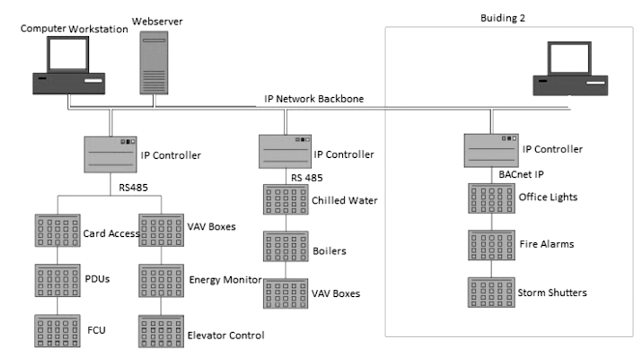Building Management System
Building Management System
A Building Management System (BMS), otherwise known as a Building Automation System (BAS), is a computer-based control system installed in buildings that controls and monitors the building's mechanical and electrical equipment such as ventilation, lighting, power systems, fire systems, and security systems. A BMS consists of software and hardware; the software program, usually configured in a hierarchical manner, can be proprietary, using such protocols as C-Bus, Profibus, and so on. Vendors are also producing a BMS that integrates the use of Internet protocols and open standards such as Device Net, SOAP, XML, BACnet, Lon Works and Modbus The Building Automation System (BAS) core functionality is to keep building climate within a specified range, light rooms based on an occupancy schedule, monitor performance and device failures in all systems and provide malfunction alarms. Automation systems reduce building energy and maintenance costs compared to a non-controlled building. Typically they are financed through energy and insurance savings and other savings associated with pre-emptive maintenance and quick detection of issues.
Building automation is the automatic centralized control of a building's heating, ventilation and air conditioning, lighting and other systems through a Building Management System (BMS) or Building Automation System (BAS). The objectives of building automation are improved occupant comfort, efficient operation of building systems, and reduction in energy consumption and operating costs. Building automation is an example of a distributed control system, the computer networking of electronic devices designed to monitor and control the mechanical, security, fire and flood safety, lighting (especially emergency lighting), HVAC and humidity control and ventilation systems in a building. BMS core functionality keeps building climate within a specified range, provides light to rooms based on an occupancy schedule, monitors performance and device failures in all systems, and provides malfunction alarms to building maintenance staff. A BMS should reduce building energy and maintenance costs compared to a non-controlled building. Almost all multi-story green buildings are designed to accommodate a BMS for the energy, air and water conservation characteristics. Electrical device demand response is a typical function of a BMS, as is the more sophisticated ventilation and humidity monitoring required of tight insulated buildings. Most green buildings also use as many low-power DC devices as possible, typically integrated with power over Ethernet wiring, so by definition always accessible to a BMS through the Ethernet connectivity. A building controlled by a BMS is often referred to as an intelligent building or smart building. Commercial and industrial buildings have historically relied on robust proven protocols like BACnet.
Almost all multi-story green buildings are designed to accommodate a BMS for the energy, air and water conservation characteristics. Electrical device demand response is a typical function of a BMS, as is the more sophisticated ventilation and humidity monitoring required of "tight" insulated buildings. Most green buildings also use as many low-power DC devices as possible, typically integrated with power over Ethernet wiring, so by definition always accessible to a BMS through the Ethernet connectivity.

Comments
Post a Comment